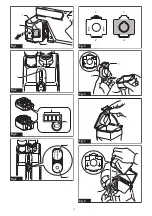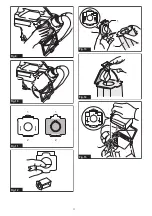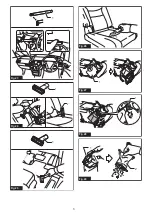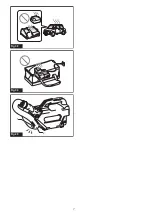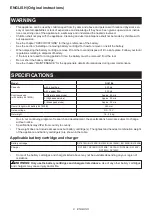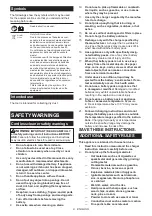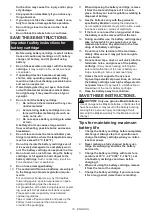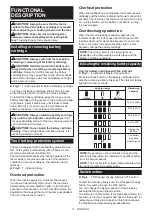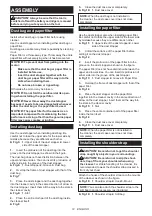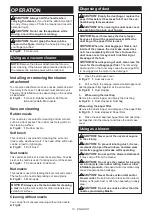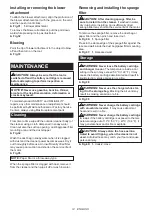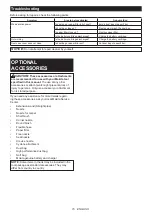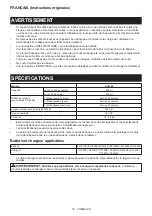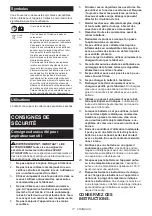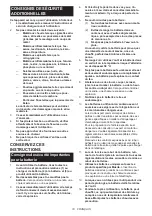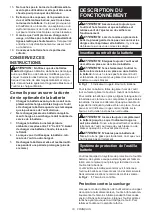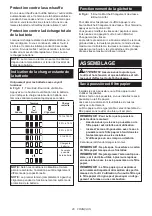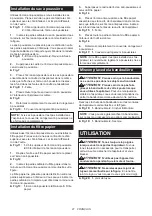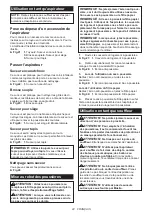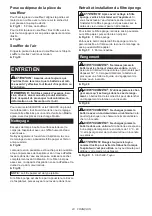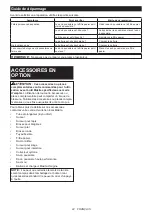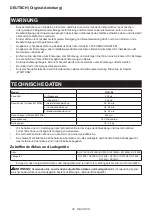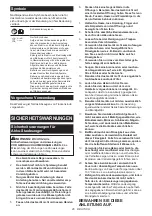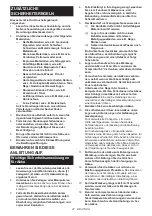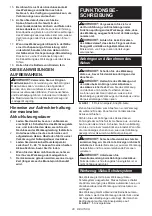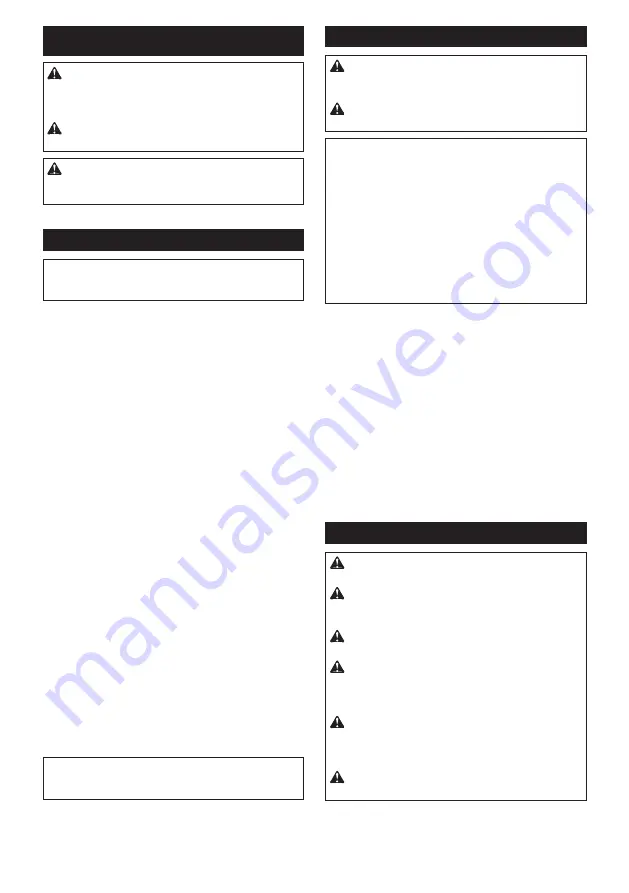
13 ENGLISH
OPERATION
CAUTION:
Always hold the handle when
carrying the cleaner.
If you hold the attachment part
to carry, it may come off from the cleaner and result in
personal injury.
CAUTION:
Do not use the appliance while
driving a car or the engine is running.
CAUTION:
Do not grasp the hose joint as
shown in the figure.
Holding the hose joint may get
your finger pinched.
►
Fig.20:
1.
Hose joint
Using as a vacuum cleaner
NOTE:
Remove the blower attachment before vac-
uum cleaning. If the blower attachment is attached to
the cleaner, the suction power will be reduced.
Installing or removing the cleaner
attachment
To connect an attachment such as a nozzle, twist and insert
it securely to the hose. To disconnect, twist and remove it.
The way of installation varies depending on the nozzles
as illustrated.
►
Fig.21:
1.
Hose
2.
Rubber nozzle
3.
Soft brush
4.
Seat nozzle
5.
Mat nozzle
Vacuum cleaning
Rubber nozzle
This nozzle is convenient for cleaning bottom corners
such as a door pocket. The rubber nozzle is gentle to
the cleaning surface.
►
Fig.22:
1.
Rubber nozzle
Soft brush
This nozzle is convenient for cleaning the air condi-
tioner vents, dashboard, etc. The head of the soft brush
can be turned to right angle.
►
Fig.23:
1.
Soft brush
Seat nozzle
This nozzle has lint brush to clean the seat surface. The side
brush on the nozzle is useful for raking dust out of the seams.
►
Fig.24:
1.
Seat nozzle
2.
Side brush
Mat nozzle
This nozzle is used for cleaning the floor mat and carpet.
The teeth on the nozzle help raking out sand grains.
►
Fig.25:
1.
Mat nozzle
NOTICE:
Always use the mat nozzle for cleaning
a mat.
Using the mat nozzle for other materials may
scratch its surface.
Cleaning without nozzle
You can perform vacuum cleaning without the nozzle.
►
Fig.26
Disposing of dust
CAUTION:
Empty the dust bag or replace the
paper filter before it becomes full. If not, the suc
-
tion/blowing force weakens.
CAUTION:
When closing the dust case cover,
be careful not to pinch your fingers.
NOTICE:
Never throw away the dust stopper
because it should be used whenever either the
dust bag or the paper filter is used.
NOTICE:
When the dust bag/paper filter is not
inside of the cleaner, the dust case cover does
not close completely. Do not force to close the
dust case cover. It may result in deforming or
breakage of the tool.
NOTICE:
When disposing of dust, also clean the
room for the dust bag/paper filter.
The remaining
dust and dirt in the room may cause the sponge filter
to be clogged or the motor to be damaged.
1.
Open the dust case cover.
►
Fig.27:
1.
Dust case cover
2.
Pull out both the orange-colored dust stopper and
dust bag/paper filter together at the same time.
►
Fig.28:
1.
Dust stopper
3.
When using the dust bag
Remove the dust stopper and empty the dust bag.
►
Fig.29:
1.
Dust stopper
2.
Dust bag
When using the paper filter
Remove the dust stopper and dispose of the paper filter.
►
Fig.30:
1.
Dust stopper
2.
Paper filter
4.
Place the dust bag/new paper filter and dust stop
-
per together into the cleaner and close the dust case
cover.
Using as a blower
CAUTION:
Never point the nozzle at anyone
in the vicinity.
CAUTION:
To prevent inhaling dust, it is rec-
ommended to open the windows, and also wear
protective goggles and mask while operating.
CAUTION:
Do not pull the blower attachment.
It may come off from the cleaner.
CAUTION:
Do not use the cleaner for blowing
air into objects, like rubber rafting, balls or other
inflatable products.
Increased motor revolution may
cause dangerous fan breakage.
CAUTION:
Never block suction inlet and/or
blower outlet.
Be careful not to block suction inlet or
blower outlet with dust or dirt when operating in dusty
area.
CAUTION:
Do not use nozzles other than the
nozzles provided by Makita.
Summary of Contents for DCL184
Page 2: ...2 1 2 3 Fig 1 1 Fig 2 1 2 Fig 3 2 1 Fig 4 1 2 1 2 Fig 5 1 2 3 Fig 6 Fig 7 1 Fig 8 ...
Page 3: ...3 Fig 9 1 Fig 10 1 2 1 2 Fig 11 Fig 12 1 2 3 Fig 13 Fig 14 1 Fig 15 ...
Page 4: ...4 Fig 16 1 Fig 17 1 2 3 Fig 18 1 2 Fig 19 1 Fig 20 1 2 3 4 5 Fig 21 1 Fig 22 ...
Page 5: ...5 1 Fig 23 2 1 Fig 24 1 Fig 25 Fig 26 1 Fig 27 1 Fig 28 1 2 Fig 29 ...
Page 6: ...6 1 2 Fig 30 1 Fig 31 Fig 32 Fig 33 Fig 34 Fig 35 1 Fig 36 1 Fig 37 ...
Page 7: ...7 Fig 38 Fig 39 1 2 Fig 40 ...
Page 94: ...94 ...
Page 95: ...95 ...


